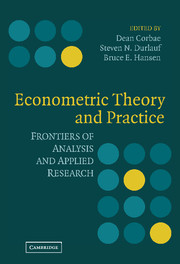Book contents
- Frontmatter
- Contents
- Preface: In Praise of a Remarkable Teacher
- Contributors
- Introduction
- PART I HIGHER-ORDER ASYMPTOTICS
- PART II IV SPECIFICATION TESTS
- PART III NONSTATIONARITY
- 6 Extracting Cycles from Nonstationary Data
- 7 Nonstationary Nonlinearity: An Outlook for New Opportunities
- 8 Multiple Structural Change Models: A Simulation Analysis
- PART IV LAD AND QUANTILE REGRESSION
- PART V NONSTATIONARY PANELS
- Index
7 - Nonstationary Nonlinearity: An Outlook for New Opportunities
Published online by Cambridge University Press: 05 June 2012
- Frontmatter
- Contents
- Preface: In Praise of a Remarkable Teacher
- Contributors
- Introduction
- PART I HIGHER-ORDER ASYMPTOTICS
- PART II IV SPECIFICATION TESTS
- PART III NONSTATIONARITY
- 6 Extracting Cycles from Nonstationary Data
- 7 Nonstationary Nonlinearity: An Outlook for New Opportunities
- 8 Multiple Structural Change Models: A Simulation Analysis
- PART IV LAD AND QUANTILE REGRESSION
- PART V NONSTATIONARY PANELS
- Index
Summary
INTRODUCTION
It has long been recognized that many economic and financial time series data exhibit nonstationarity that can be reasonably well modeled as integrated processes. Integrated processes have stochastic trends, which allow us to build their relationships using the notion of cointegration. As is well known, cointegration refers to the presence of a linear relationship among multiple integrated processes that holds up to stationary and mean-reverting residuals, and it has thus been widely used to describe various long-run economic equilibria. Although the concept of cointegration has been received enthusiastically by many applied researchers, its practical implementation appears not to have been entirely successful. In particular, we have not witnessed many meaningful empirical findings on the subject despite the numerous attempts that have been made by many practitioners for the past two decades. Most of them seem to have found nothing beyond our common sense.
Both integration and cointegration, respectively, as a means of modeling observed individual time series and describing relationships among them, often appear to be too restrictive to be very useful in practical applications. For instance, many time series observed in reality are bounded yet locally nonstationary and behave like integrated processes. Clearly, such time series cannot be effectively modeled as integrated processes that should necessarily be unbounded. It is also apparent that any time series taking only nonnegative values cannot be generated by an integrated process.
- Type
- Chapter
- Information
- Econometric Theory and PracticeFrontiers of Analysis and Applied Research, pp. 178 - 211Publisher: Cambridge University PressPrint publication year: 2006
- 1
- Cited by

